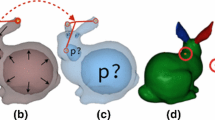Abstract
Purpose
A finite element (FE) head and neck model was developed as a tool to aid investigations and development of deformable image registration and patient modeling in radiation oncology. Useful aspects of a FE model for these purposes include ability to produce realistic deformations (similar to those seen in patients over the course of treatment) and a rational means of generating new configurations, e.g., via the application of force and/or displacement boundary conditions.
Methods
The model was constructed based on a cone-beam computed tomography image of a head and neck cancer patient. The three-node triangular surface meshes created for the bony elements (skull, mandible, and cervical spine) and joint elements were integrated into a skeletal system and combined with the exterior surface. Nodes were additionally created inside the surface structures which were composed of the three-node triangular surface meshes, so that four-node tetrahedral FE elements were created over the whole region of the model. The bony elements were modeled as a homogeneous linear elastic material connected by intervertebral disks. The surrounding tissues were modeled as a homogeneous linear elastic material. Under force or displacement boundary conditions, FE analysis on the model calculates approximate solutions of the displacement vector field.
Results
A FE head and neck model was constructed that skull, mandible, and cervical vertebrae were mechanically connected by disks. The developed FE model is capable of generating realistic deformations that are strain-free for the bony elements and of creating new configurations of the skeletal system with the surrounding tissues reasonably deformed.
Conclusions
The FE model can generate realistic deformations for skeletal elements. In addition, the model provides a way of evaluating the accuracy of image alignment methods by producing a ground truth deformation and correspondingly simulated images. The ability to combine force and displacement conditions provides flexibility for simulating realistic anatomic configurations.




Similar content being viewed by others
References
Nath SK, Simpson DR, Rose BS, Sandhu AP (2009) Recent advances in image-guided radiotherapy for head and neck carcinoma. J Oncol 2009:1–10
van Kranen S, van Beek S, Rasch D, van Herk M, Sonke J (2009) Setup uncertainties of anatomical sub-regions in head-and-neck cancer patients after offline CBCT guidance. Int J Radiat Oncol Biol Phys 73:1566–1573
Ahn PH, Ahn AI, Lee CJ, Shen J, Miller E, Lukaj A, Milan E, Yaparpalvi R, Kalnicki S, Garg MK (2009) Random positional variation among the skull, mandible, and cervical spine with treatment progression during head-and-neck radiotherapy. Int J Radiat Oncol. Biol. Phys. 73:626–633
Zeng GG, Breen SL, Bayley A, White E, Keller H, Dawson L, Jaffray DA (2009) A method to analyze the cord geometrical uncertainties during head and neck radiation therapy using cone beam CT. Radiother Oncol 90:228–230
Lee C, Langen KM, Lu W, Haimerl J, Schnarr E, Ruchala KJ, Olivera GH, Meeks SL, Kupelian PA, Shellenberger TD, Manon RR (2008) Assessment of parotid gland dose changes during head and neck cancer radiotherapy using daily megavoltage computed tomography and deformable image registration. Int J Radiat Oncol Biol Phys 71:1563–1571
Kashani R, Hub M, Balter JM, Kessler ML, Dong L, Zhang L, Xing L, Xie Y, Hawkes D, Schnabel JA, McClelland J, Joshi S, Chen Q, Lu W (2008) Objective assessment of deformable image registration in radiotherapy: a multi-institution study. Med Phys 35:5944–5953
Hou J, Guerrero M, Chen W, D’Souza WD (2011) Deformable planning CT to cone-beam CT image registration in head-and-neck cancer. Med Phys 38:2088–2094
Al-Mayah A, Moseley J, Hunter S, Velec M, Chau L, Breen S, Brock K (2010) Biomechanical-based image registration for head and neck radiation treatment. Phys Med Biol 55:6491–6500
Nithiananthan S, Schafer S, Uneri A, Mirota DJ, Stayman JW, Zbijewski W, Brock KK, Daly MJ, Chan H, Irish JC, Siewerdsen JH (2011) Demons deformable registration of CT and cone-beam CT using an iterative intensity matching approach. Med Phys 38:1785–1798
Nithiananthan S, Brock KK, Daly MJ, Chan H, Irish JC, Seiwerdsen JH (2009) Demons deformable registration for CBCT-guided procedures in the head and neck: convergence and accuracy. Med Phys 36:4755–4764
Rohlfing T (2012) Image similarity and tissue overlaps as surrogates for image registration accuracy: widely used but unreliable. IEEE Trans Med Imaging 31:153–163
Brock KK, Sharpe MB, Dawson LA, Kim SM, Jaffray DA (2005) Accuracy of finite element model-based multi-organ deformable image registration. Med Phys 32:1647–1659
Li P, Malsch U, Bendl R (2008) Combination of intensity-based image registration with 3D simulation in radiation therapy. Phys Med Biol 53:4621–4637
Tanner C, Schnabel JA, Hill DLG, Hawkes DJ, Leach MO, Hose DR (2006) Factors influencing the accuracy of biomechanical breast models. Med Phys 33:1758–1769
Schnabel JA, Tanner C, Castellano-Smith AD, Degenhard A, Leach MO, Hose DR, Hill DLG, Hawkes DJ (2003) Validation of nonrigid image registration using finite-element methods: application to breast MR images. IEEE Trans Med Imaging 22:238–247
Zhong H, Kim J, Chetty IJ (2010) Analysis of deformable image registration accuracy using computational modeling. Med Phys 37:970–979
Gilad I, Nissan M (1986) A study of vertebra and disc geometric relations of the human cervical and lumbar spine. Spine 11:154–157
Zhang QH, Teo EC, Ng HW, Lee VS (2006) Finite element analysis of moment–rotation relationships for human cervical spine. J Biomech 39:189–193
Hedenstierna S, Halldin P (2008) How does a three-dimensional continuum muscle model affect the kinematics and muscle strains of a finite element neck model compared to a discrete muscle model in rear-end, frontal, and lateral impacts. Spine 33:E236–E245
Acknowledgments
This work was supported by NIHP01CA59827.
Author information
Authors and Affiliations
Corresponding author
Ethics declarations
Conflict of interest
Jihun Kim, Kazuhiro Saitou, Martha Matuszak, and James Balter have no conflict of interest.
Rights and permissions
About this article
Cite this article
Kim, J., Saitou, K., Matuszak, M.M. et al. A finite element head and neck model as a supportive tool for deformable image registration. Int J CARS 11, 1311–1317 (2016). https://doi.org/10.1007/s11548-015-1335-6
Received:
Accepted:
Published:
Issue Date:
DOI: https://doi.org/10.1007/s11548-015-1335-6




